
-
![St. Donatus' church in Roman forum in Zadar]() Provided by: Phant/shutterstock
Provided by: Phant/shutterstock

Our travel guides are free to read and explore online. If you want to get your own copy, the full travel guide for this destination is available to you offline* to bring along anywhere or print for your trip.
*this will be downloaded as a PDF.Price
€4,95
Church of St Donatus
The guide was updated:The Church of St Donatus is considered by many the symbol of Zadar. This majestic circular building is one of the finest examples of Byzantine style in the whole country. Nowadays it's no longer used as a church but as a venue for cultural and musical events.
The ground floor houses a permanent exhibition of the medieval collection. The first floor is dedicated to the permanent exhibition of the ancient collection. The second floor shows off the permanent exhibition of the prehistoric collection.
Useful Information
- Address: Crkva sv. Donata, Šimuna Kožičića Benje, Zadar
- Opening hours: Changes seasonally. Check the official website for up-to-date information
- Website: www.amzd.hr
- Email: info@amzd.hr
Digital Travel Guide Download
Our travel guides are free to read and explore online. If you want to get your own copy, the full travel guide for this destination is available to you offline* to bring along anywhere or print for your trip.
*this will be downloaded as a PDF.Price
€4,95

The Church of St Donatus is considered by many the symbol of Zadar. This majestic circular building is one of the finest examples of Byzantine style in the whole country. Nowadays it's no longer used as a church but as a venue for cultural and musical events.
The ground floor houses a permanent exhibition of the medieval collection. The first floor is dedicated to the permanent exhibition of the ancient collection. The second floor shows off the permanent exhibition of the prehistoric collection.
Read more

Cathedral of St Anastasia
This Romanesque Cathedral was built in the 12th century on the plan of a former Christian basilica and it's the biggest one in the Dalmatian region. Behind the ornamented facade, remains of frescoes and a carved choir decorate the interiors of the church. From the top of the bell tower visitors can enjoy views of the old town below.
Read more

The Roman Forum
Commissioned by emperor Augustus in the 1st century, the Roman Forum (today known as Zeleni trg) was the heart of public life during the empire and it's nowadays the most genuine image of the city's ancient appearance. Remains of the original pavement, stairs and two monumental columns of the Roman square are among the most well-preserved ruins of the sight.
Read more
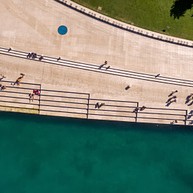
Sea Organ
This series of broad white steps descending into the sea are one of the most unique landmarks in Zadar. Designed by the local architect Nikola Bašić, the Sea Organ consists of underwater resonant chambers carved in the steps which allow the organ to play chiming notes when the water flows into them.
Read more

Museum of Ancient Glass
An outstanding collection of glass items, many of them hailing from the Roman settlements around the region and the local Roman necropolis. Glass-blowing and bead making demonstrations are available every day.
Read more

People’s Square
Since its origin in the Medieval times, Narodni Trg (People’s Square) has been the core of Zadar's public life. The City Guard, built in 1562, commands the western side of the square, topped by a 19th-century clock tower. Nearby, St Lawrence church is the oldest preserved building of the town, while the Loggia on the opposite side is now a venue for exhibitions.
Read more

Church of St Simeon
Despite its humble exterior, this small Baroque church, named after one of the patron saints of the city, houses one of Zadar's highlights: the St Simeon Chest.
A fine example of medieval silversmithing, dating back to 1381, this highly decorated silver casket placed just above the main altar contains the mummified body of St Simeon.
Read more

Land Gate & City Walls
Traces of the old city walls can still be found all around Zadar, with some sections dating back to the Middle Ages and a greater part built during the Venetian control over the city as a fortification against the Turks. Beside some portions of the previous walls, eight gates used as entrances to the city remain, of which the most elaborate is the one known as Land Gate.
Located just in front of the little Foša harbour, Land Gate is adorned with some of the finest Dalmatian Renaissance-style decorations, including representations of Saint Chrysogonus and the lion of St Mark.
Read more
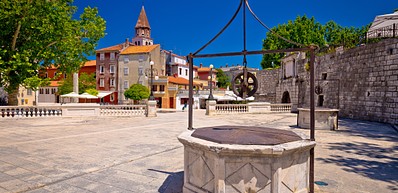
Five Wells Square
Trg Pet Bunara owes its name to the five wells lining up in a row at its centre, which has supplied water to the city until the middle of the 19th century. Just a few steps away visitors can enjoy Queen Jelena Madije park, situated just between the medieval walls and the Renaissance Grimani bastion.
Read more
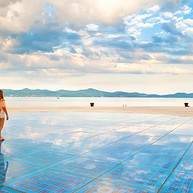
Greeting to the Sun
The eccentric Pozdrav Suncu attracts tons of people every evening during summer. By the same architect of the Sea Organ, Nikola Bašić, Greeting to the Sun is a compound of multi-layered plates in circular shape inserted on the pavement of Riva promenade. Collecting energy from the sun during daylight, it displays a show of light patterns representing the movements of the Solar System from sunset to sunrise.
Read more

Permanent Exhibition of Religious Art
Hosted within the Benedictine monastery of St Mary, this permanent exhibition of religious art is one of the most valuable in Croatia and displays a number of masterpieces made out of gold and silver, but also other precious items such as manuscripts, embroideries, reliefs and tapestry.
Read more

Archaeological Museum
The Archaeological Museum houses a collection of artefacts from the district of Zadar and the islands of Pag and Rab, dating from prehistoric times to the end of 11th century.
Read more
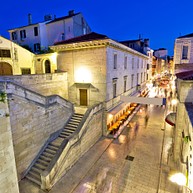
Kalelarga
Lined with shops, bars and cafes, Kalelarga is the biggest and busiest street in Zadar. Following the trail of the ancient Decumanus Maximus built by the Romans, it's the place where people in Zadar come for socialising and having fun and where many events take place all year round.
Read more

National Museum
The National Museum showcases exhibits of the natural, cultural and ethnological heritage of the northern Dalmatian region from the 13th century until present days. The museum encompasses four departments: Natural History, Ethnology, Fine Arts and City Museum.
Read more

Zadar Archipelago
Zadar archipelago gives visitors the possibility to discover one of the most beautiful areas of Dalmatia away from the more touristy part of the region. It may be popular with fishing enthusiasts, but there are plenty of activities for everyone to enjoy like snorkelling, cave exploring and cliff jumping.
Read more

Church of St Chrysogonus
A notable part of the great Benedictine monastery that was destroyed in World War II, the Church of St Chrysogonus houses beautifully preserved 13th-century frescoes and a Baroque altar.
Read more

Treasury of the Franciscan Monastery
The Treasury exhibits valuable examples of sacred art: the large Romanesque painted crucifix from the 12th century, the painting of the Dead Christ — the work of Jacopo da Ponte Bassano, the large Renaissance crucifix from the 15th century, ancient liturgical vessels, precious illuminated codices and chorals, documents, incunabula, etc. The painted Ugljan polyptych from the 15th century is without any doubt the finest and the most representative example of the entire Gothic painting in Croatia.
Read more

St Michael's Church & Monastery
On the corner of Špiro Brusina Street and Mihovil Klaić Street there is a simple and charming Gothic Church of St Michael’s, once a part of the Franciscan monastery. A Gothic portal, which is adorned by reliefs from the 14th century, dominates the facade. In its single-nave interior there is a painted wooden Romanesque crucifixion from the 13th century. There is also a small collection of art works in the monastery. The present church was built in 1389 and added to in the 19th century.
Read more
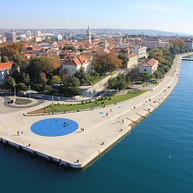
Riva
The sea promenade called Riva is a wonderful place to walk around and enjoy its beautiful green parks and palm trees. It is a first class city promenade with the view over the Zadar channel, the islands of Ugljan and Pašman and the open sea to the northwest.
Read more


